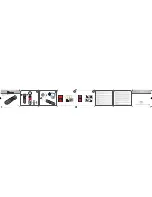
DMTA-10045-01EN, Rev. E, August 2016
Applications
133
Figure 6
‑
16 The list of all parameters
6.1.2
Detecting Skin-to-Core Disbonds in Honeycomb Composite —
Tapered or Varying Geometry Using PC Swept Technique
The pitch-catch (PC) swept technique is ideal for inspecting honeycomb composite
parts with tapered or varying geometry. This technique works well on a variety of
skin and cores, but it works especially well with aluminum honeycomb cores.
The PC Swept technique typically works better for near-side disbonds than far-side
disbonds. It can also be used to inspect flatter or constant geometry parts, although
the RF and IMPULSE techniques are typically preferred for such parts, particularly
for thicker assemblies.
This procedure describes how to set up for a typical PC Swept inspection, using an
aluminum core standard. The choice of the frequency range (normally selected and
recommended by the part’s manufacturer) should be respected.
Inspection materials are shown in Figure 6-17 on page 134.
Summary of Contents for BondMaster 600
Page 8: ...DMTA 10045 01EN Rev E August 2016 Table of Contents viii ...
Page 10: ...DMTA 10045 01EN Rev E August 2016 List of Abbreviations x ...
Page 26: ...DMTA 10045 01EN Rev E August 2016 Important Information Please Read Before Use 16 ...
Page 28: ...DMTA 10045 01EN Rev E August 2016 Introduction 18 ...
Page 32: ...DMTA 10045 01EN Rev E August 2016 Chapter 1 22 ...
Page 72: ...DMTA 10045 01EN Rev E August 2016 Chapter 3 62 ...
Page 78: ...DMTA 10045 01EN Rev E August 2016 Chapter 4 68 Figure 4 2 Crosshairs and the NULL point ...
Page 130: ...DMTA 10045 01EN Rev E August 2016 Chapter 5 120 ...
Page 216: ...DMTA 10045 01EN Rev E August 2016 Chapter 7 206 ...
Page 230: ...DMTA 10045 01EN Rev E August 2016 Appendix A 220 ...
Page 234: ...DMTA 10045 01EN Rev E August 2016 Appendix B 224 ...
Page 240: ...DMTA 10045 01EN Rev E August 2016 List of Figures 230 ...
Page 242: ...DMTA 10045 01EN Rev E August 2016 List of Tables 232 ...















































